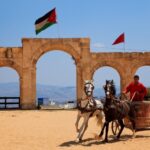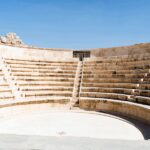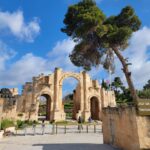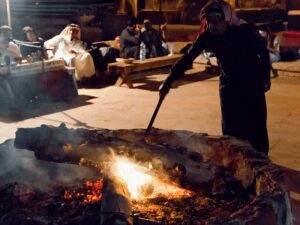Can history be touched, felt, and walked through? In Jerash, ancient history is not just an abstraction; it’s an immersive, tactile experience that rises from the ruins, echoing the footsteps of Roman legions that once patrolled the Decapolis.
The past is palpable.
Within these time-worn stones lie secrets of a bygone era, waiting to be unveiled. Each column, temple, and plaza holds a narrative of ancient grandeur, beckoning the modern traveler to step back into history.
Unveiling Jerash Grandeur
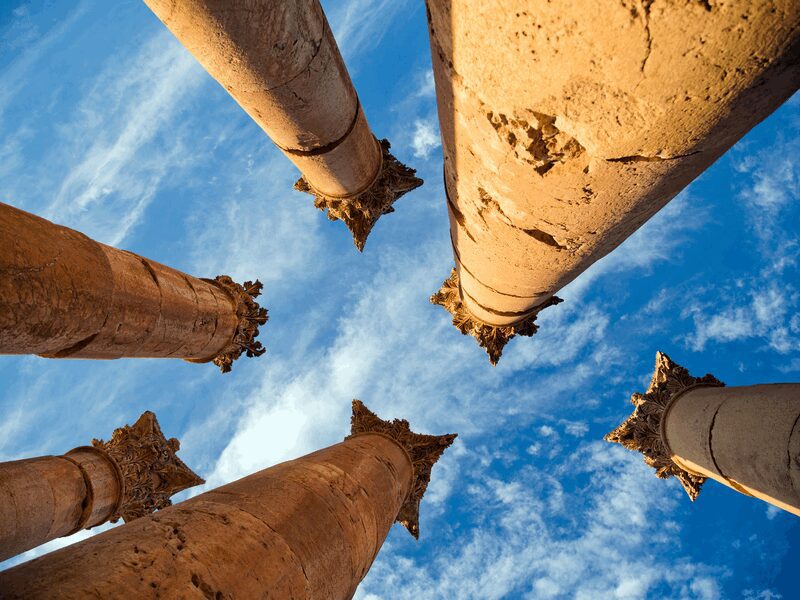
Amidst the rolling hills of northern Jordan lies Jerash, a testament to Roman architectural prowess and city planning. Its well-preserved streets, lined with towering columns and magnificent temples, serve as a remarkable conduit for understanding the complexities of ancient urban life.
The colossal structures, from the imposing Triumphal Arch to the stately Forum, reverberate with the echoes of a once thriving metropolis. These remnants of human ingenuity offer a window into the sophistication and artistry of the classical world.
Triumphal Arch Centuries-old Welcome
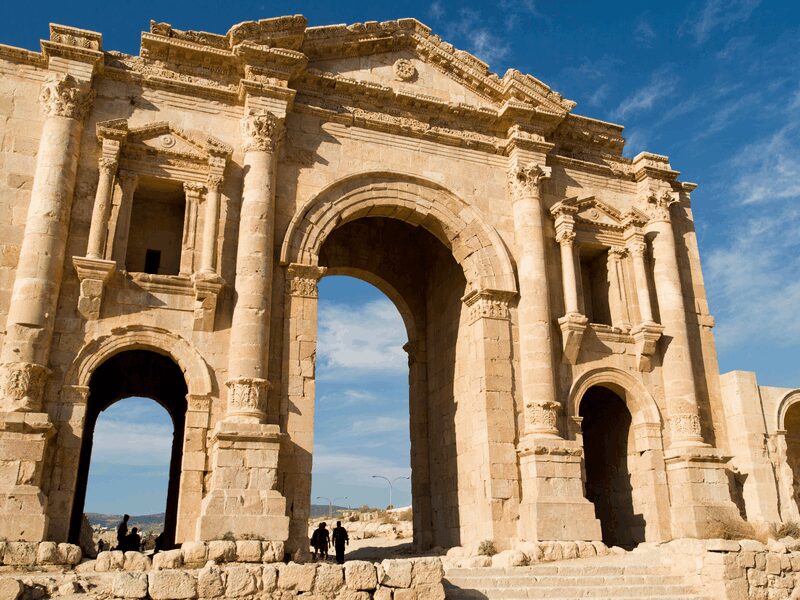
The Triumphal Arch of Jerash stands as an emblem of ancient glory, an imposing gateway through which countless visitors have passed. Symbolizing victory and prosperity, it has endured millennia, a testament to Roman engineering and artistry.
Erected to honor the visit of Emperor Hadrian in 129 A.D., its grandeur captivates the imagination akin to a “portal through time”. Guests are greeted by an architectural marvel that merges historical significance with intricate design elements.
The Arch was intended to be part of a grander expansion that was never completed.
Defying the ravages of time: The Triumphal Arch invites exploration of a realm where the past is intrinsically woven with the present (although physical extensions were slated for construction, history took a different turn). Sturdy and elegant, it remains a defining feature of Jerash, a prelude to the wonders that lie beyond its gracious curve.
Hippodrome Chariot Race Echoes
The Hippodrome of Jerash, once resonant with the thunder of hooves, retains an air of excitement that time has not erased.
Envision the roar of an eager crowd, the rush of chariots battling for dominance on the elongated U-shaped track. This historical spectacle, rich with tradition and adrenaline, once showcased the skill and bravado of charioteers and horses alike. Here, tales of victory and defeat were written into the dust beneath pounding hooves and wheel spokes, accompanied by the clamorous acclamations of captivated spectators.
Today, even absent the spectacle of a full chariot race, the Hippodrome’s structure stands as a monument to these exhilarating contests. Its corridors and arches, although silent, evoke a palpable sense of the energy and pageantry that once filled this space. Visitors navigating the site can almost hear the echoing cheers of ancient audiences reverberating off the stone bleachers.
The Hippodrome’s restored semblance remains indicative of the city’s sporting heritage, offering a glimpse into the competitive spirit that thrived within these grounds. With extensive seating capacity and sophisticated starting gates, the structure underpins Jerash’s reputation as a site where the blend of architectural prowess and entertainment mirrored the grandeur of the Roman Empire. This arena bore witness to countless races, immortalizing the drama of competition within its enduring grounds, inviting contemporary audiences to ponder the vibrant cultural tableau that was ancient Jerash.
Temple Complexes: Devotion in Stone
The temples of Jerash exemplify the profound religious fervor of the Roman period, translating worship into architectural marvels. The Temple of Artemis, dominating the skyline with its Corinthian columns, speaks to a society that married spirituality with stunning artistry. Amid the colonnaded streets, this impressive edifice exemplifies how religion was not just an emotional pursuit, but also a paramount cultural expression realized in limestone magnificence.
At the heart of religious life in Jerash, the sanctuary spaces were designed as tangible tributes to divine entities. The Temple of Zeus, for instance, offers an elevated platform and sanctuary, known as a “temenos”, bounded by formidable boundary stones, “peribolos”. Set against the stunning backdrop of the Gerasa valley, these temple structures narrate tales of piety and architectural prowess, standing as gatekeepers of ancient cosmic beliefs – as reverent as they were grandiose in their prime.
Zeus Sanctuary: Olympus in Jordan
The Temple of Zeus presides over Jerash, a testament to ancient worship rendered in stone and scale.
- Altar of Sacrifice: Where offerings to the deity were made amidst the scents of incense and burning flesh.
- Temenos: The sacred precinct that created a microcosm of the heavens on earth for Zeus’s veneration.
- Columned Porticoes: Echoing the grandeur of Olympus, framing the temple and providing a stately approach.
- Peribolos: The boundary stones marking hallowed ground, demarcating the divine from the mortal realm.
Perched on a promontory, it once offered pilgrims a vista mirroring the might of the gods.
This sanctuary in Jordan, a counterpart to the splendor of Mount Olympus, sits as an enduring relic of devotional ambition.
Artemis Temple Majestic Pillars
The Temple of Artemis, with its towering columns, embodies an aura of divine strength and durability, illustrating the goddess’s virginal virtue through monumental architecture.
These Corinthian columns stand as behemoths of cultural craftsmanship that have defied centuries.
Rising from the earth toward the heavens, each column exemplifies Hellenistic artistry and Roman engineering genius.
The play of sunlight and shadow among the columns creates a dance of light which exalts its celestial patroness.
In this temple’s design, we observe a harmonious combination of function and form; the pillars are not merely structural but also serve as emblematic representations of Artemis’ untarnished purity and elegance.
Indeed, these pillars are silent yet profound narrators of time’s passage, their resilience a testament to the ingenuity of the ancient architects who envisioned and erected them.
Social Hubs of Ancient Life
The agora and the forum served as central arenas for social interaction in Roman Jerash, functioning as the pulsating heart of the city’s daily life. These were spaces of convergence, where a mix of economic trade, political discourse, and communal gatherings unfolded in a rich tapestry of urban vitality. Here, citizens would assemble, not only to engage in commerce but also to partake in the exchange of ideas and local governance, reflecting the democratic ethos of the period.
Within this bustling framework lay the baths, venues of relaxation and renewal that catered to the city’s populace. Functioning akin to a ‘cultural salon’, these thermal establishments provided an intimate glimpse into the social customs of the time. Within their walls, citizens from varied walks of life convened to soothe their bodies and spirits. The baths were more than mere hygienic facilities; they were a nexus of culture and a physical embodiment of the community’s emphasis on leisure, health, and social engagement amidst the grandeur of Roman architecture.
Forum Oval Allure
The Forum of Jerash captivates with its impressively large oval shape, surrounded by a sequence of Ionic columns, epitomizing the urban grandeur that flourished under Roman rule. Its geometry breaks from the traditional rectangular Roman forum, creating a unique architectural footprint in the ancient cityscape.
Its elliptical form is both functional and aesthetic, a marvel of ancient city planning.
These majestic columns, originally numbering 56, supported an intricately detailed entablature that once bore the weight of bustling activity within. As the central stage of civic life, the Forum facilitated a convergence of commerce, politics, and community events emblematic of ancient urban centers.
The Forum’s scale and design exemplify Roman engineering prowess, ingeniously accommodating crowds through its expansive area earmarked for public gatherings. Beyond its utilitarian role, the elliptical space echoed the sounds of oratory, the flow of people and goods, the vigor of religious ceremonies, and the dramatic interplay of light and shadow across the colonnades. Here, the spatial narrative of Jerash was written, punctuated by the stately rhythm of Corinthian columns and the ebullient life thriving in their midst. The Forum’s enduring allure lies not just in its ruins, but in the echoes of ‘agora’ life it continues to whisper across millennia.
The Long Walk: Cardo Maximus
The Cardo Maximus stands as an enduring testament to the grandeur of Roman urban design, stretching with a stately elegance through the heart of Jerash.
- Northern Tetrapylon: A grand entryway marking the starting point of the Cardo Maximus, adorned with four sets of four columns each.
- Columned Street: An expansive, colonnaded boulevard that was once the bustling main artery of the city, lined by towering columns.
- Central Intersection: The heart of the thoroughfare, where the Cardo Maximus intersects with the South Decumanus, another significant street.
- Nymphaeum: A monumental public fountain situated along the Cardo, symbolizing the city’s wealth through its elaborate, ornate decorations.
- Macellum: The remains of a vibrant marketplace that once served the daily needs of Jerash’s residents, located nearby the Cardo.
Traversing the length of the Cardo Maximus offers a journey back in time, where the echoes of ancient footsteps seem almost audible.
With every step, visitors are enveloped in the architectural grandeur and historical resonance that define the Cardo’s miles-long passage.
Preserved for Posterity
Amidst the golden sands of time, the ancient city of Jerash boasts an exceptional state of preservation, surpassing that of many contemporaneous sites. The remarkable conservation efforts have enabled the surviving structures to withstand millennia, offering an unaltered glimpse into Roman urbanism. Intricate stonework endures, arrayed along the Cardo Maximus, as testament to Roman engineering prowess and the city’s former grandeur.
In the shadow of history, meticulous archaeological endeavors persist, safeguarding Jerash’s legacy for future generations. This “Pompeii of the East” stands not merely as a relic but as a vibrant tapestry of past life, woven into the present memory. As one traverses its thoroughfares, the meticulous spatial planning and the amplitudes of communal spaces become evident, inviting contemplation of the everyday lives once led within this remarkable enclave of antiquity.
The Nymphaeum’s Fountain Whispers
In hushed tones, the Nymphaeum’s remnants beckon visitors, hinting at the social import the fountain once commanded in Roman Jerash.
Water, the lifeblood of the ancients, animated this grand structure.
Centrally located, the Nymphaeum stood as a monument to both utility and opulence, its cascading waters a display of Roman engineering and affluence amidst the arid landscape.
With an elegance that transcends time, the Nymphaeum’s ruins suggest the past’s reverence for water, hinting at a society that celebrated its preciousness with such ornate public fountains. Here, in the whispers of flowing waters, one might imagine the gossamer threads of conversations that once danced over the cool, mist-laden breeze.
The Theaters’ Resonant Drama
Jerash’s ancient theaters echo with the vestiges of Roman dramatic arts, resonating through the stone corridors and seating tiers.
- Southern Theater: Constructed in the 1st century AD, it once held over 3000 spectators, offering them acoustical perfection.
- Northern Theater: Smaller yet significant, built in the 2nd century AD, it functioned not only for entertainment but also for city council meetings.
Strategically designed, these theaters maximized acoustics, ensuring even the faintest whispers could be heard throughout the auditorium.
Their state of preservation offers a tangible connection to the past, allowing visitors to envisage the grandeur of Roman performances.


